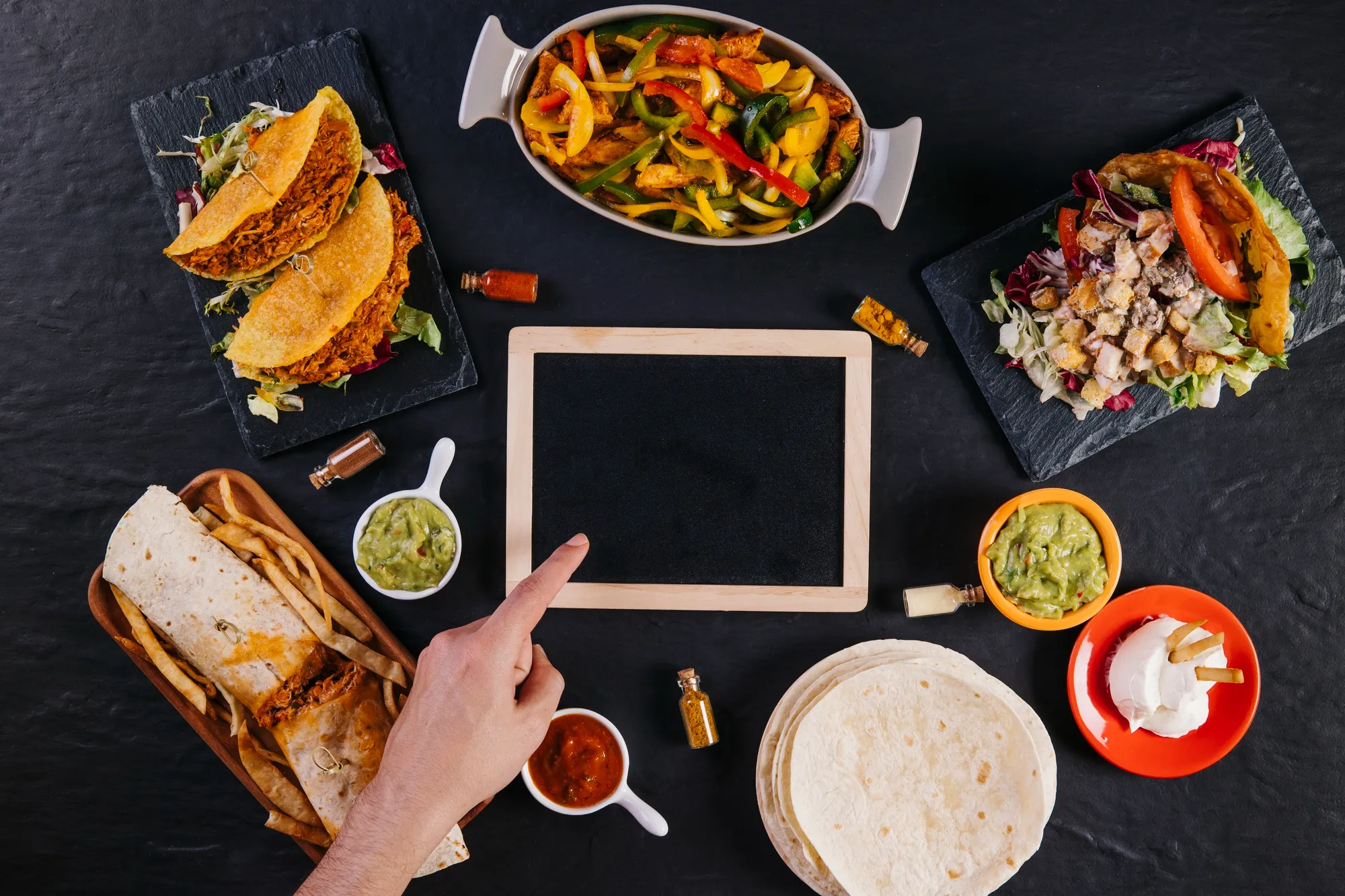In the competitive world of Mexican food, more and more restaurants and businesses face the challenge of standing out in a saturated market. The popularity of dishes like tacos, burritos, enchiladas, and guacamole has led to a surge in demand, which means that businesses need to find creative ways to stand out and attract more customers. But how do you achieve this when competition is so fierce?
The simple answer: through a solid SEO (Search Engine Optimization) strategy. SEO is the most powerful tool to increase online visibility and position your Mexican food business at the top of search results. This guide will show you how to use specific keywords so that search engines like Google place your business front and center, attracting customers eager to try your dishes.
What Are SEO Keywords and Why Are They Important?
SEO keywords are the terms people type into search engines like Google when looking for something specific. For example, if a customer is searching for a place to buy tacos al pastor, they may look for “best tacos al pastor in [city].” This set of words forms what we call a keyword. In simple terms, keywords connect what people are searching for with the content you offer on your website.
Keywords are vital for SEO because search engines use them to index and rank web pages. When you optimize your website with relevant keywords, search engines consider your content relevant for those search terms. This improves your visibility, increasing the chances that more people will find your business. In the Mexican food context, choosing and using the right keywords could be the difference between appearing in Google’s top search results or getting lost in the crowd.
Keyword Research for Mexican Food Businesses
Effective keyword research is essential for any Mexican food business aiming to stand out online. Finding the right keywords can help attract more customers, boost your search engine rankings, and bring in a targeted audience that’s already interested in what you offer. Below are some top tools and keyword types to consider for enhancing your business’s online visibility.
Tools for Keyword Research
Here are some powerful tools that can assist in finding the best keywords to target:
- Google Keyword Planner: This is a free tool that helps discover popular search terms that users frequently look for. By typing in a few ideas, you can get a list of related keywords, search volume, and trends, making it easier to identify terms that resonate with your audience.
- SEMrush: Known for its competitive analysis, SEMrush allows you to track keywords that similar businesses are using. It provides insights into keyword difficulty, trends, and related terms that can inspire content ideas.
- Ahrefs: This tool is excellent for competitor analysis. Ahrefs helps you uncover which keywords your competitors are ranking for and identifies keyword opportunities for your business. It also provides information on backlink sources, which can improve your SEO strategy.
Types of Keywords to Target
Understanding the types of keywords and how to use them is vital to reach your ideal audience effectively:
- Short-tail keywords: These are broad, high-competition keywords, such as “Mexican food” or “tacos.” While they attract large volumes of traffic, ranking for these terms can be challenging due to high competition. However, using them can help your business appear in broad search results and boost brand visibility.
- Long-tail keywords: More specific phrases like “authentic Mexican catering for events in [city]” or “family-friendly Mexican restaurant near me.” These keywords have lower search volumes but target specific customer intentions, making it easier to rank and more likely to attract customers actively looking for your services.
Incorporating a mix of these keywords into your website, blogs, and social media can improve your chances of reaching a wider audience, from those looking for general information to those ready to make a purchase or visit.
Extensive List of Relevant Keywords for Mexican Food
Here is a list of relevant SEO keywords specific to Mexican food:
| Category | Keywords |
| Dishes | tacos, burritos, enchiladas, quesadillas, mole, pozole, tamales, guacamole, nachos, chile relleno |
| Ingredients | corn, beans, chili, avocado, cilantro, queso fresco, tortillas, hot sauce, crema, nopales |
| Occasions | Mexican food to go, Mexican catering, Mexican food for events, Mexican food for parties |
| Location | Mexican food in [city], taquería in [neighborhood], Mexican restaurant in [area] |
| Attributes | authentic Mexican food, homemade Mexican food, healthy Mexican food, traditional Mexican food |
100 Long-Tail Keywords for Mexican Food
Here is a comprehensive list of 100 long-tail keywords specific to Mexican food. These detailed keywords attract a more targeted audience and help you rank for specific searches:
| Long-Tail Keywords |
| best tacos al pastor in [city] |
| authentic Mexican food restaurant in [city] |
| homemade carne asada taco recipes |
| Mexican taquería in [your neighborhood] |
| Mexican food catering for parties in [city] |
| Mexican food to-go in [city] |
| best burritos near me in [city] |
| nachos with homemade guacamole in [city] |
| healthy Mexican food to-go in [city] |
| affordable Mexican catering for events in [city] |
| vegan Mexican restaurant in [city] |
| easy guacamole recipe for tacos |
| where to find pozole in [city] |
| best authentic tacos near me in [city] |
| traditional Mexican food for parties |
| homemade Mexican recipes for beginners |
| healthy Mexican food for families |
| Mexican restaurant with gluten-free options in [city] |
| best Mexican enchiladas in [city] |
| homemade salsa verde recipe for enchiladas |
| Mexican food for lunch in [city] |
| best chilaquiles in [city] |
| catering for Mexican weddings in [city] |
| homemade tortillas recipe for Mexican tacos |
| where to find authentic Mexican mole in [city] |
| best tacos dorados in [city] |
| authentic Mexican food restaurant with delivery in [city] |
| homemade tamales recipe for holidays |
| best Mexican food trucks in [city] |
| healthy Mexican salad recipes for lunch |
| where to buy fresh tortillas in [city] |
| best Mexican restaurant for family dinners in [city] |
| where to find tacos de carnitas in [city] |
| best Mexican restaurant for takeout in [city] |
| tamales for Christmas in [city] |
| traditional Mexican food for large events |
| vegan tacos in [city] |
| Mexican catering for corporate events in [city] |
| top Mexican restaurants in [city] |
| how to make carne asada tacos at home |
| easy Mexican recipes for beginners |
| top Mexican restaurants with patio seating in [city] |
| where to buy fresh Mexican salsa in [city] |
| best burritos for delivery in [city] |
| homemade fajitas recipe with fresh ingredients |
| authentic Mexican quesadillas with cheese |
| top 10 Mexican restaurants in [city] |
| best places for Mexican street food in [city] |
| how to make traditional Mexican tortillas |
| easy taco salad recipes with chicken |
| best places for Mexican catering in [city] |
| where to buy fresh Mexican tamales in [city] |
| Mexican restaurant with outdoor seating in [city] |
| how to make pozole rojo at home |
| Mexican restaurants with kid-friendly menus in [city] |
| vegan Mexican burritos in [city] |
| traditional Mexican catering for events in [city] |
| how to make homemade guacamole in under 10 minutes |
These 100 long-tail keywords are more specific and detailed, helping you capture a more defined audience. They are excellent for competing in narrower niches and increasing your conversion rates as they usually have less competition than generic keywords.
If you’d like to see more on how a successful keyword strategy is applied to a Mexican restaurant, we invite you to check out our success story with Avocados Restaurant in Bradenton, FL.
How to Use Keywords Effectively in Your Content?
Now that you’ve gathered a list of impactful keywords, using them effectively across your website is key to maximizing their SEO value. Proper keyword integration can help your content appear more relevant to search engines, driving more organic traffic to your site. But remember, it’s not about cramming keywords everywhere; it’s about placing them naturally and strategically for a seamless user experience.
Titles and Subtitles
Titles and subtitles are prime real estate for keywords, as they help both search engines and readers understand the main topics of your content. Be intentional with your primary keywords in these areas. For example, a title could be “Best Tacos in [City]: Authentic Mexican Flavors,” while a subtitle might be “Mexican Catering Services for Events in [City].” These are engaging phrases that communicate your content’s value to potential customers.
Within the Text
Incorporate your keywords naturally throughout the content. Avoid “keyword stuffing,” which can make text awkward and impact readability. Instead, let keywords flow in a way that enhances the user experience. For example, while describing your dishes, you could say, “Our menu highlights traditional carne asada tacos, freshly made tortillas, and homemade guacamole.”
Meta Descriptions
Meta descriptions are short, informative snippets under your title in search results that can attract more clicks. Use this opportunity to integrate a primary keyword like “authentic Mexican restaurant” or “best Mexican food in [city]” to appeal directly to searchers. Keep it concise yet inviting, ensuring it summarizes the page’s content and entices people to visit your site.
Heading Tags
Search engines pay attention to heading tags (H1, H2, H3, etc.) to understand content structure and relevance. Each heading should incorporate relevant keywords while enhancing readability. For instance, an H1 tag could be “Authentic Mexican Dishes,” while H2 tags might include “Mexican Dishes for All Occasions” or “Top Catering Services for Your Next Event.”
User-Friendly URLs
Your URLs also contribute to SEO and user experience. Create descriptive URLs that reflect the content and include keywords, such as “authentic-mexican-catering” or “tacos-in-city.” A clean, keyword-rich URL can improve your site’s visibility and make it easier for users to remember.
Image Optimization
Images are an often-overlooked opportunity for keyword optimization. Use descriptive, keyword-based file names like “carne-asada-tacos.jpg” and fill in the “alt text” with relevant phrases such as “authentic carne asada tacos” or “fresh Mexican guacamole.” This helps improve your SEO, as search engines can interpret your images better, and it also enhances accessibility for visually impaired users.
Optimizing Your Website for Mexican Food SEO
Beyond keyword usage, there are several technical strategies to enhance your website’s SEO, helping you attract more traffic and improve the user experience.
Loading Speed
A slow website can frustrate users and increase bounce rates. To ensure your site loads quickly, optimize your images by compressing them without sacrificing quality and leverage tools like Google PageSpeed Insights for recommendations on reducing load times. Additionally, minimize code and consider using a Content Delivery Network (CDN) to speed up content delivery.
Responsive Design
With most local searches now happening on mobile devices, having a mobile-friendly website is essential. A responsive design will automatically adjust to fit any screen size, ensuring users have a seamless experience on phones, tablets, or desktops. Test your site on multiple devices to ensure functionality and easy navigation across all platforms.
Internal Structure
A clear, well-organized internal structure improves both user experience and SEO. Divide your content into logical categories, such as “Tacos,” “Catering Services,” and “Specialties,” and use internal links to guide users from one section to another. For example, linking a page on “Authentic Tacos” to a page on “Mexican Catering” helps users explore related services, keeping them engaged and lowering bounce rates.
Internal and External Links
Links are critical for SEO, helping search engines understand site relevance and credibility. Use internal links to help users navigate within your site, leading them to related products or services. Additionally, include external links to reputable sources, like food blogs or well-reviewed customer testimonials, to build authority and trust. For example, linking to a popular local food blog that reviewed your restaurant can enhance credibility and drive traffic.
Additional SEO Strategies for Mexican Food Businesses
Implementing additional strategies beyond on-page SEO can significantly boost your visibility, attract new customers, and keep your audience engaged. Here are some effective methods to enhance your online presence.
Blogging
Creating a blog with engaging, Mexican food-related topics—like recipes, cultural insights, event ideas, and cooking tips—not only keeps your content fresh but also improves search engine rankings. Regularly posting relevant content helps establish your brand as an authority and attracts organic traffic. For example, posts on “Best Mexican Dishes for Parties” or “The History of Tacos” can engage your audience while enhancing SEO.
Social Media Integration
Social media platforms are powerful tools to drive traffic to your site and boost SEO. Sharing posts about new menu items, special events, or seasonal promotions can attract customers and encourage engagement. Visual platforms like Instagram and Facebook are particularly effective for showcasing delicious dishes and promoting user-generated content, like customer photos and reviews, which further boosts credibility and search ranking.
Google My Business Optimization
Optimizing your Google My Business (GMB) profile is essential for appearing in local search results and the “Local Pack.” Complete all fields with accurate and detailed information, including hours, contact information, and photos (you can view a complete guide on how to optimize GMB here). Encourage satisfied customers to leave reviews on GMB, as positive reviews improve your ranking in local searches, especially for “near me” queries.
Local Listings and Directories
Registering your business in local directories, such as Yelp, TripAdvisor, and Zomato, enhances your visibility and credibility. Make sure that your contact information, hours, and location are consistent across all platforms. Consistent listings help Google verify your business information, which can positively impact local search rankings and improve your chances of being discovered by nearby customers.
Email Marketing
Email marketing is an excellent tool for keeping customers engaged and driving repeat visits. Regular newsletters featuring exclusive discounts, event invitations, or holiday promotions remind customers of your offerings and encourage loyalty. Special offers can also be timed to drive traffic back to your site, especially during slower seasons or before big events. Including links to recent blog posts or menu updates in your emails can further enhance website visits and engagement.
Conclusion
In the world of Mexican food, where competition is fierce, a solid SEO strategy is essential to stand out and attract more customers. Using the right keywords in the appropriate content, along with optimizing your website, will help improve your visibility and make your business shine. Start implementing these strategies today and watch your online presence grow exponentially!






